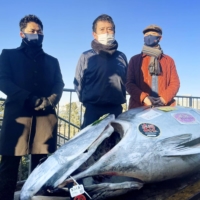Underreported catches are weighing on Japan’s management system for Pacific bluefin tuna stocks, with a government official saying that a major reporting failure that came to light late last year was only the “tip of the iceberg.”
To prevent the overfishing of bluefin tuna, the country’s Fisheries Agency sets a separate catch quota for tuna weighing less than 30 kilograms and those weighing over 30 kilograms under a relevant international agreement. Based on the quotas, the agency allocates catches to each prefecture and fishing method.
Fishery operators are asked to observe the catch quotas and obliged to report their actual catches.
But in November last year, it was learned over 10 tons of famous Oma-brand bluefin tuna, caught off Aomori Prefecture, had been shipped outside the northeastern prefecture without being reported. Such cases are likely fairly common, the government official said.
The high value of Oma-brand bluefin tuna was apparently a factor in the case. At Tokyo’s Toyosu wholesale market, an Oma-brand tuna fetched a record sum of over ¥300 million in the 2019 New Year’s auction.
Intermediate wholesalers at the Toyosu market are worried that the case may hurt the Oma brand’s image.
Oma-brand tuna “have been assessed as the best tuna” since before the market was relocated from the Tsukiji area, an intermediate wholesaler said. “To maintain the tuna’s brand power, I hope that catch data will be properly reported and managed.”
The owner of a sushi restaurant in Tokyo’s Shibuya Ward said the restaurant recommends Oma tuna to customers, calling it the best tuna in Japan. “Fishers should proudly ship it without concealing data,” the owner added.
In a bid to keep illegal products out of markets, the Fisheries Agency is slated to introduce a system in December that will oblige operators to maintain their transaction records. However, the new system will not cover such records on bluefin tuna but only those on abalone and other items at higher risk of poaching.
It is expected to remain difficult to accurately monitor catches and distribution routes of bluefin tuna in Japan. If the lax controls are left unchanged, the country could face growing criticism from the international community, observers said.
Gakushuin University professor Isao Sakaguchi, an expert on fishery resources management, is calling for bluefin tuna to be included in the list of items under the new system.
“It’s necessary to impose penalties to buyers (of illicit products) as well,” Sakaguchi said.
Masayuki Komatsu, president of the Tokyo-based Ecosystem Research Institute, said that in some foreign countries reports are required for purchases at places from fish markets to restaurants.
“Japan should thoroughly and promptly implement world-standard resources management,” Komatsu stressed.
On the management of the Pacific bluefin tuna stock, the Western and Central Pacific Fisheries Commission, of which Japan, the United States and other nations are members, introduced international restrictions, including catch quotas, in 2015.
Following the move, tuna stocks recovered to about 28,200 tons in 2018 from a record low of about 10,800 tons in 2010.
In a time of both misinformation and too much information, quality journalism is more crucial than ever.
By subscribing, you can help us get the story right.



